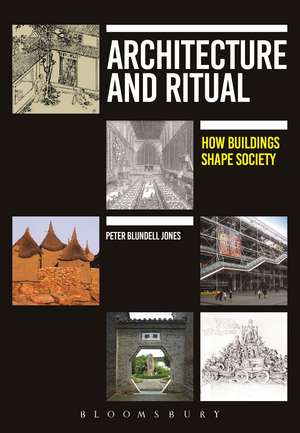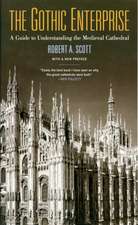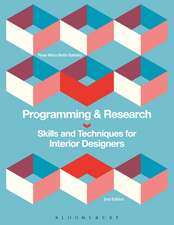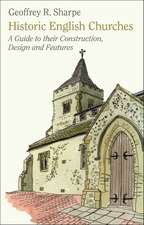Architecture and Ritual: How Buildings Shape Society
Autor Professor Peter Blundell Jonesen Limba Engleză Paperback – 24 aug 2016
| Toate formatele și edițiile | Preț | Express |
|---|---|---|
| Paperback (1) | 205.77 lei 6-8 săpt. | |
| Bloomsbury Publishing – 24 aug 2016 | 205.77 lei 6-8 săpt. | |
| Hardback (1) | 780.73 lei 6-8 săpt. | |
| Bloomsbury Publishing – 24 aug 2016 | 780.73 lei 6-8 săpt. |
Preț: 205.77 lei
Preț vechi: 235.05 lei
-12% Nou
Puncte Express: 309
Preț estimativ în valută:
39.38€ • 40.86$ • 32.91£
39.38€ • 40.86$ • 32.91£
Carte tipărită la comandă
Livrare economică 15-29 martie
Preluare comenzi: 021 569.72.76
Specificații
ISBN-13: 9781472577481
ISBN-10: 1472577485
Pagini: 392
Ilustrații: 280 bw illus
Dimensiuni: 169 x 244 x 18 mm
Greutate: 0.75 kg
Editura: Bloomsbury Publishing
Colecția Bloomsbury Academic
Locul publicării:London, United Kingdom
ISBN-10: 1472577485
Pagini: 392
Ilustrații: 280 bw illus
Dimensiuni: 169 x 244 x 18 mm
Greutate: 0.75 kg
Editura: Bloomsbury Publishing
Colecția Bloomsbury Academic
Locul publicării:London, United Kingdom
Caracteristici
Social focus of study provides a contrast to other architectural histories: to understand a piece of architecture, an awareness of the society who created and use the building is required
Notă biografică
Peter Blundell Jones was Professor of Architecture at the University of Sheffield from 1994 until his death in 2016. He previously held teaching positions at the University of Cambridge and at London South Bank University, and was a prominent architectural writer, critic and historian.
Cuprins
Chapter 1 IntroductionPart 1: Power and PoliticsChapter 2 Black Rod and the Three Knocks on the Door Chapter 3 The Lord Mayor's BanquetChapter 4 The Imperial Chinese Magistrate and his YamenChapter 5 The Nuremberg Rally of 1934Part 2: People and their TerritoriesChapter 6 Hunter-Gatherer Architecture: The Australian Aborigines Chapter 7 The Oglala Sioux and the Four DirectionsChapter 8 The Tukanoan MalocaChapter 9 The Dogon of MaliChapter 10 The Dong, Building Types and Building RitualsPart 3: Modernities Chapter 11 The European FarmsteadChapter 12 The HospitalChapter 13 The Opera and the Concert HallChapter 14 The Fun Palace Project, Centre Pompidou and Paradoxical Ideas of FreedomChapter 15 Conclusion BibliographyIndex
Recenzii
Using examples ranging from farmhouses to hospitals to Cedric Price's Fun Palace, Peter Blundell Jones shows how the use of buildings is intimately tied to their social meaning. This carefully researched and well-argued book thereby helps re-cast architectural theory, bringing together separate frameworks-function, aesthetics and cultural value-into a single discourse.
For those working in urban studies, Architecture and Ritual provides an important perspective onhow human societies at any scale (family, tribe, city, nation) form and are formed by their builtenvironments. It would be especially helpful for anyone working to understand people's ways of life inthe metropolitical context and how these ways are, to a significant degree, influenced by theirarchitecture.
In a major contribution to the study of the anthropology of building, Peter Blundell Jones explores architecture's role as a setting for communal rituals, balancing familiar and less familiar examples from a range of cultures to provide many insights into the shared origins of different expressions in the buildings of both modern and traditional societies.
For those working in urban studies, Architecture and Ritual provides an important perspective onhow human societies at any scale (family, tribe, city, nation) form and are formed by their builtenvironments. It would be especially helpful for anyone working to understand people's ways of life inthe metropolitical context and how these ways are, to a significant degree, influenced by theirarchitecture.
In a major contribution to the study of the anthropology of building, Peter Blundell Jones explores architecture's role as a setting for communal rituals, balancing familiar and less familiar examples from a range of cultures to provide many insights into the shared origins of different expressions in the buildings of both modern and traditional societies.






